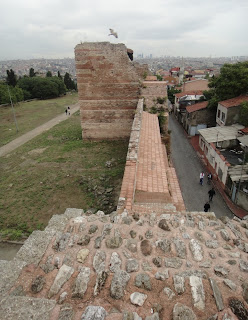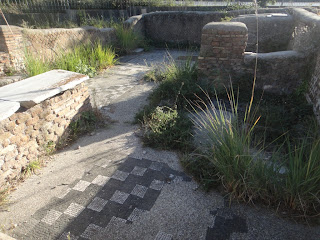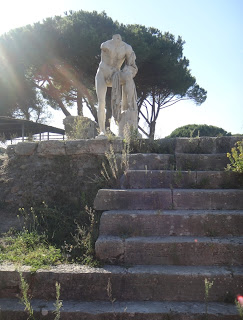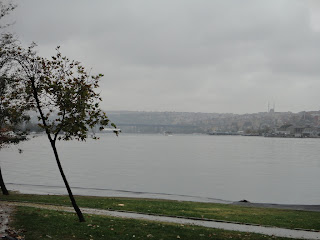(Pammakaristos church)
(Guess)
The adventures continue. In reality, they never really stop over here. Any dead time not working becomes dedicated to figuring out the next excitement—concerts in town, museum exhibitions, gallery showings, festivals, churches, the list goes on and on. The past two weeks seem extra adventurous too since I spent five days in Rome, attending a conference and revisiting my old haunts. For now, I will entertain you (hopefully) with an educational tour of churches in Istanbul, shenanigans (photos) from Rome, and some jazzy good times in my neighborhood.
(Chora Church frescoes)
Istanbul—not just a city of beautiful mosques…
As I am sure most of you know, before Istanbul was the capital of the Ottoman Empire, that is to say, before Istanbul was Istanbul, it was Constantinople and it was Christian (Eastern Orthodox Christian), and it was filled with churches. Some of these architectural and artistic gems survive into the present day—as mosques, museums, and even as still-functioning churches. On a Sunday (how appropriate), I tagged along with some fellow fellows (fellows who knew something on Byzantine art and architecture) and toured these spaces.
(Chora Church)
Basilica of St. George:
We began our adventure at the current seat of the Ecumenical Patriarchy of Constantinople, the principal Greek Orthodox cathedral in the city—a place, recognized by most Eastern Orthodox Christians as the spiritual leader of their church organization. We were lucky enough to visit at the close of a service, which was a wonderful experience to see the space filled with worshippers, to hear the songs resound in the hall, to watch those in attendance greet the church’s clergy and kiss the icons. It added life and energy to space and objects that I otherwise would have viewed as a museum. A much appreciated experience.
The church itself, named after the Christian martyr St. George, has served as the seat of the patriarchy since 1586. It is located in the neighborhood of Fener, which is (or was once) the center of Greek life in Istanbul. Despite its symbolic status, the basilica is a rather unassuming building from the exterior, especially when compared the more ornate churches we visited that day, but its interior, primarily the product of late-18th century renovations, is lavishly decorated with mosaics, marble, gilded wood, and chandeliers.
The church also houses some famous relics, included the patriarchal throne believed to date to the 5th century and the bones of Gregory the Theologian and John Chrysostom—taken from Constantinople in the 4th crusade (1204) and returned in 2004 by Pope Johnny Paul.
Additionally, on the church grounds stands the largest wooden structure in Istanbul.
Pammakaristos Church (Fethiye Mosque):
After a walk along the Golden Horn and the longest coffee break ever, it was off to the next church, up the hill, through winding worn-down streets, past the daily life of Istanbul with kids in the street begging that we take their picture and old men at cafes watching us curiously pass.
After a few wrong turns, we make it the church, a structure dating to the 11th century, situated on a hill in Fatih overlooking the Golden Horn. The Pammakaristos church served as the seat of the patriarchy from 1456-1586, when it was moved to the Basilica of St. George. The main building of the church was converted into a mosque in 1591 after Sultan Murad III conquered Georgia and Azerbaijan (Fetih = conquest). The original church was greatly altered in order to function as a mosque, which it still does to this day, but the side chapel, built in the Late Byzantine period (14th century) is still accessible and provides an excellent window into religious space from this period.
This structure with a typical cross-in-square plan has 5 domes and numerous mosaic panels as well as a few frescoes. A beautiful and photogenic space with few tourists. Completely worth the winding route to get there.
Chora Church:
Listed as one of the most beautiful examples of Byzantine churches, the Chora church does not disappoint. Located in the area of Edirnekapi, overlooking a peaceful public garden space, the church is a wonder. Rising domes and expanding buttresses lure one around the exterior of the apse to the entrance [and this whole area is filled with some of the cutest and friendliest cats in all of Istanbul! One just jumped in my lap and fell asleep—so I might be a little biased toward this church J ].
The site itself has housed a church since the early 5th century when the structure was located outside the city walls (hence the name Chora, which means fields). It was quickly incorporated into the city, but kept its nomenclature. In the 16th century it was turned into a mosque and its exquisite frescoes and mosaics were covered over with plaster. In 1948, it was renovated and turned into a secularized museum, displaying its rich iconographic program and stunning marble paneling for all visitors.
The core of the current building dates to the late 11th century, but the mosaics and paintings are from 1315-1321. Again, the artwork (though the photos do little justice to) is incredible—anytime one can see 600+ year old paintings in the original locations is an incredible experience. The only down side is that it was a small space, but still fairly crowded, which made it a little difficult to appreciate the pieces. But, yes, a definite must for anyone staying more than 3 days in Istanbul (I’m developing a priority of sight-seeing/to do lists in Istanbul based on the number of days one is in town).
After this adventure, we were walking out to the bus stop and ran right into the Theodosian walls!!! 5th century fortification walls that continue to strongly mark the landscape. So we climbed them, took photos, and ran around for a bit. I am now determined to pack a picnic and a couple of beers and spend an afternoon up there reading and sitting and looking.
Ruins in Rome:
Ostia

How can you not love Rome? Even if you’ve never been there, it still has an appeal. Everywhere you look is attractive, breath-taking, smile-inducing. It is such a magic city—the ruins of the ancient past, the art of the renaissance, the monuments of the modern period, the food of your dreams, the shopping that breaks the bank; even when passing by the riot police, I couldn’t help but notice how attractive they were J Sure, there is graffiti and trash, and, ok the bus schedule is erratic to non-existent, and the metro is too crowded and threatens pick-pocketing, but still…one cannot leave Rome with a bad experience.
In the summer of 2007, I lived in Rome for a month. I shared an apartment in Trastevere with three girls and every weekday we went out to excavate the synagogue at Ostia. It was a great summer, but I have done so much traveling since then that I had forgotten how much I absolutely enjoyed Rome. It was great to get back and remind myself what a fantastic place it is…walk the same streets, eat and drink at my old haunts, visit my old site, get lost on the same alleys, and, of course, the best part of all of this was to do it all alongside my dear friend, colleague, twitter follower/followee, shopping consultant, Rome-lover, and great academic role model, Doug Boin (that’s Dr. Boin of Georgetown University!).
My old street!
My square in Trastevere!
Favorite meal and favorite restaurant, Gusto!
The most amazing Prosciutto and Mozzarella I've ever had!!!
A great few days. I went into town for a conference on Roman Memory and in order to pick up my research visa for Turkey (success on both ventures). I came in a few days early to revisit Ostia and spend some time with Doug before the conference got into full swing.
Ostia
Theater at Ostia
The synagogue--my old trench is in the back left corner
Synagogue as the sun sets
I don’t want to keep you too much on the academic side of things—the conference was amazing, the speakers excellent, I really honed my networking skills, and I saw a fascinating talk by architect, Daniel Libeskind, to close out the trip. All of this I’m happy to discuss with those who want more details, but for now, I’ll leave it at that.
Courtyard at the American Academy at Rome
Villa Aurelia, property of American Academy
And instead, I've decided to just give you pictures from my trip. I do plan to write a little bit about my interesting experience during the riots—no, not being directly a part of them, but running around the city trying to catch a bus all the while not realizing there were riots going on or that the busses had stopped because of the riots. But until that time…enjoy the sights.
Ostia
Doug's temple at Ostia :)
Roman forum
View from Villa Aurelia, note the smoke. Riots, maybe?
And I Return
I returned to a rain-soaked Istanbul on Sunday evening—apparently, it had rained every day since I left—and went back to business as usual.
Welcome additions to the social calendar for the week were the Akbank Jazz Festival and the Efes Pilsen Blues Festival. Oh how I had such plans for these events…but alas money and exhaustion got the best of me. I did make it out to one show successfully though. Wednesday is my long day. We have afternoon tea at 4, which leads to presentations by fellows from 4:30-6 or so, followed by wine and snacks, followed by 7pm dinner and then Turkish lessons from 8-9:30. To top all this off, this Wednesday, I decided to go to a jazz show with some of the other fellows. Such a great decision. The artist, Arto Tuncboyaciyin, is an Armenian percussionist who plays an eclectic mix of soulful tunes with upbeat jam sessions, along with another percussionist and keyboardist. http://www.theguideistanbul.com/events/music/concerts/arto-tuncboyaciyans-1to3-82680.html For this performance he was accompanied by a xylophone player who was amazing!!! I had no idea one could play like that. It was also housed in a great venue, a club (Ghetto) that I had been meaning to go to for a while now. Great space and architecture. Will definitely go back for a night of dancing. (sorry that they are a little dark)
I also had plans to go to a show Friday night, but tickets were 40 TL and so a little out of my price range for one show. As for the Blues Festival on Saturday, the long Friday night (instead of going to the jazz show we ended up at a pub until 3am) made me less than enthusiastic about another night out, so I opted for a night of cooking and a movie. A good decision.
Street popcorn and street beer!
View flying over Italy to Rome!
Hope you enjoyed the blog! Keep reading, keep sharing, and keep in touch :)





























































